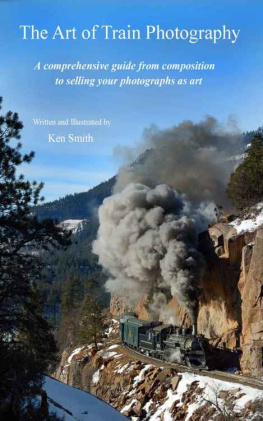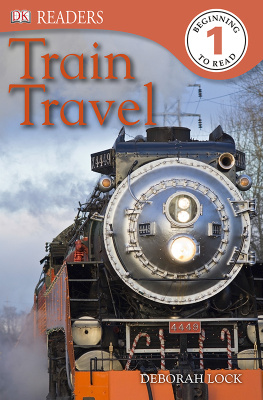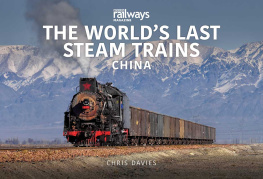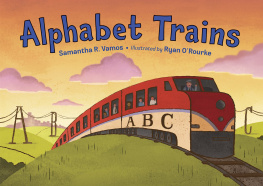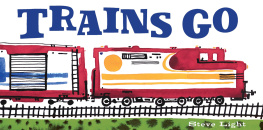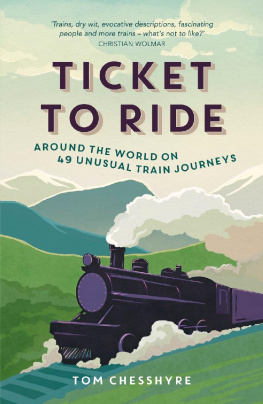Smith - The Art of Train Photography
Here you can read online Smith - The Art of Train Photography full text of the book (entire story) in english for free. Download pdf and epub, get meaning, cover and reviews about this ebook. year: 2012, genre: Science fiction. Description of the work, (preface) as well as reviews are available. Best literature library LitArk.com created for fans of good reading and offers a wide selection of genres:
Romance novel
Science fiction
Adventure
Detective
Science
History
Home and family
Prose
Art
Politics
Computer
Non-fiction
Religion
Business
Children
Humor
Choose a favorite category and find really read worthwhile books. Enjoy immersion in the world of imagination, feel the emotions of the characters or learn something new for yourself, make an fascinating discovery.
- Book:The Art of Train Photography
- Author:
- Genre:
- Year:2012
- Rating:3 / 5
- Favourites:Add to favourites
- Your mark:
- 60
- 1
- 2
- 3
- 4
- 5
The Art of Train Photography: summary, description and annotation
We offer to read an annotation, description, summary or preface (depends on what the author of the book "The Art of Train Photography" wrote himself). If you haven't found the necessary information about the book — write in the comments, we will try to find it.
Smith: author's other books
Who wrote The Art of Train Photography? Find out the surname, the name of the author of the book and a list of all author's works by series.
The Art of Train Photography — read online for free the complete book (whole text) full work
Below is the text of the book, divided by pages. System saving the place of the last page read, allows you to conveniently read the book "The Art of Train Photography" online for free, without having to search again every time where you left off. Put a bookmark, and you can go to the page where you finished reading at any time.
Font size:
Interval:
Bookmark:

CHAPTER 1
A CHILDHOOD DREAM BECOMES A PASSIONATE QUEST
The Art of Train Photography
Written by Ken Smith
Copyright 2011 -2012 all rights reserved.
Photographs and illustrations by the author unless otherwise noted.
Dedications
To my Lord and Savior Jesus Christ for with Him, all things are possible.
To my Wife Sharon, who believed in me and this project from the start.
To my friend Jeff Abbott who challenged me in 1993 by telling me that .the only thing that ever stops people from succeeding is fear.

Photo of the Durango & Silverton Railroad.
The photograph that changed my life..forever!
TABLE OF CONTENTS
CHAPTER 1
A CHILDHOOD DREAM BECOMES A PASSIONATE QUEST
CHAPTER 2
FIRST THINGS FIRST: KNOW WHAT YOU WANT AND PLAN HOW TO GET THERE
CHAPTER 3
WALK BEFORE YOU CHASE: KNOW THE BASIC SKILLS FIRST
CHAPTER 4
EQUIPMENT and ACCESSORIES
CHAPTER 5
GOING OUT in the FIELD
CHAPTER 6
POST PRODUCTION: THE MIRACLE OF SOFTWARE
CHAPTER 7
BLACK & WHITE PHOTOGRAPHY
CHAPTER 8
SELLING YOUR WORK
CHAPTER 9
SIMPLE EXCERSIZES TO TRAIN YOUR EYES
CHAPTER 10
ADDITIONAL RESOURCE INFORMATION
CHAPTER 1
A CHILDHOOD DREAM BECOMES A PASSIONATE QUEST
As everyone who loves trains seems to be connected at some juncture to a train set in their childhood, I also was no different. Located under the Christmas tree, my parents gave me my first train set when I was just seven years old . They had purchased it from a small department store that has long since closed its doors forever and g one away. My first train set was a Lionel Lines pair of Santa Fe F U nits that went around and around on a 4x8 sheet of plywood. It was set up with a simple loop with a smaller loop contained inside of the bigger loop . Also, it came with a train station, Styrofoam tunnel and a crossing gate , but I didnt care about all that when I first got it. Watching the train go around and around, again and again is what fascinated me the most. I would lie down on the floor and look at it from a life-sized perspective. I imagined that I was looking at a real train. That fascination continued to foster and so began a life filled with trains.
 Ive chased trains my whole life. From my earliest memories during childhood, I can remember my father taking me to the train stations in Chicago. Even when we moved to the south suburbs of the great Windy City, dad would bring me up to the rail yards or stations to see the trains. Being that my father was a truck driver, he seemed to know exactly where the best viewing was and I never seemed to be disappointed. I was too young to care about locomotive types, classifications, or even railroads.
Ive chased trains my whole life. From my earliest memories during childhood, I can remember my father taking me to the train stations in Chicago. Even when we moved to the south suburbs of the great Windy City, dad would bring me up to the rail yards or stations to see the trains. Being that my father was a truck driver, he seemed to know exactly where the best viewing was and I never seemed to be disappointed. I was too young to care about locomotive types, classifications, or even railroads.
An ATSF Super Chief Departs from Chicagos famous Dearborn Street Station prior to it closing in 1971 . Scenes like this from my childhood are gone forever.
The station car shed is gone . The station itself remains and is renovated into shops and office space and city park s and high rises now resides were all of this track once sat.
When we would go on vacation either out east or out west, dad would be sure that a whistle stop at some railroad would be on the agenda. My father new that I loved trains even more than he did. I didnt care about toys, sports, or anything else as a child. I just wanted to see the trains.
In my late childhood, I began photographing trains and was using various forms of film types from Kodak s Kodachrome , and Extachrome , with a borrowed camera from my parents. I continued to use my parents camera until we moved to NW Indiana to a town called Hammond. Dad still would take me to Chicago but I was also within walking distance of some of the greatest train traffic going in and out of Chicago now.
Now that I was well into my teens, I continued to experiment with all sorts of film types until I settled on Kodachrome and Ilford as my two main types of film media. This decision was based on the purchase of my first 35mm camera; a Sears and Roebucks KS-500. This camera was similar to a Pentax K-1000 but without the hefty price tag as it was back in the early 70s . Occasionally, I still see this camera pop up on forums and on EBay . It was a very rugged camera; built like a tank and weighed about as much as one too.

The first camera setup that I purchased. Everything thought that I would ever need including the bag!
I began with just two types of lenses, a 50mm 2.0 that came with the camera and a 135mm that was included in the original kit package. Camera , lenses, bag, flash and manual, all came from Sears. At the time of my purchase, Sears actually had a camera department and informed sales associates. Today, the camera department is a huge thing of the past. Anyhow, the sales associate told me that the camera and lenses were made by Ricoh even though they did not carry the brand name. Im not sure just how accurate that was, but they included the new Pentax K bayonet mount so it seemed logical to believe that it was correct information .
By the time I acquired my new camera kit , I began working for a department store . I also began reading books on photography techniques and studying train photographs as well as landscape photographs from many publications. I purchased my first car and my first railroad book shortly after. Between a used set of wheels (a 1970 VW ) and a book titled The Train Spotters Guide to tell me about all the hot spots for train spotting) I began a lifelong quest of chasing trains. Little did I know that what I assumed would be around forever would soon head off into extinction.
As a child, I saw E and F units from NYC , PRR , ATSF , UP, CB&Q, IC, L&N, EL, and countless others. I saw passenger trains before the word Amtrak even existed. I got to see the inside of engine terminals, car repair shops, and walked in rail yards, long before security was even thought to be an issue. I remember seeing hobos and trail hoppers because all of that existed when I was a kid.
 But those E&F units vanished, Amtrak came, and second and third generations diesels surface as well as mergers. Rails began to be replaced with roads or hiking paths and the evolution of the railroad took place. Today, almost nothing remains from those golden days unless it is an excursion fan trip, or parked in a museum or on display in a city park.
But those E&F units vanished, Amtrak came, and second and third generations diesels surface as well as mergers. Rails began to be replaced with roads or hiking paths and the evolution of the railroad took place. Today, almost nothing remains from those golden days unless it is an excursion fan trip, or parked in a museum or on display in a city park.
With the Willis Tower (formerly known as the Sears Tower at the time this photo was taken) , these e BN E9 units were the last units of their kind running in and out of Chicago. The formation of the Regional Transportation Authority (R.T.A.) would retire the last of these units from the BN and Rock Island.
I photographed yards in Chicago and other locations in the Chicagoland area as well as mainlines and shortlines within 60-100 miles near Chicago. If you know anything about train traffic in this area, it is one of the busiest areas in the US. Depending on a single location, it was not uncommon at all to see over a hundred trains in a day, I would arm myself with a dozen rolls of film for the day just so that I would be prepared for just about anything. I didnt know it then, but if I could have foreseen the future, I would have invested heavily into photographs with the purpose of selling them.
Next pageFont size:
Interval:
Bookmark:
Similar books «The Art of Train Photography»
Look at similar books to The Art of Train Photography. We have selected literature similar in name and meaning in the hope of providing readers with more options to find new, interesting, not yet read works.
Discussion, reviews of the book The Art of Train Photography and just readers' own opinions. Leave your comments, write what you think about the work, its meaning or the main characters. Specify what exactly you liked and what you didn't like, and why you think so.

